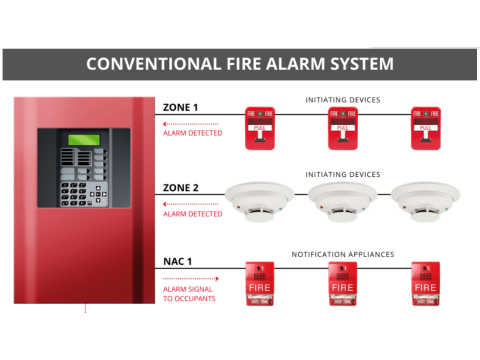HOW FIRE ALARM SYSTEMS KEEP YOU SAFE WITH SAFSALE.COM
DETECTORS
RELIABILITY AT ITS BEST
So, here's the lowdown on how an automatic fire alarm system rolls:
- Detection: Sensors pick up on factors that could spark a fire, like smoke, heat, or open flames.
- Alerting: Once something's up, these sensors send out a shout.
- Processing: Your control panel (yeah, the brains of the operation) gets the message and takes action.
Depending on the type of place and the fire gear installed, the control panel manages systems like:
- Alerts
- Fire Suppression
- Smoke Removal, and more.
When you set up remote monitoring, the system sends status updates straight to the centralized fire station control hub.
Plus, our fire alarms sync up with other tech systems, like access control (think security gates and doors).
HOW DETECTORS WORK
Fire alarm detectors (we call them IPs) are all about spotting fire-related factors: smoke, rising temps, or visible flames.
There's no one-size-fits-all detector, so during the planning phase, we figure out which factor is most likely to show up first in your space.
Based on that, we decide which type of sensor to install:
- Smoke Detectors
- Heat Detectors
- Flame Detectors
For the nitty-gritty on how each detector type works and where to use them, check out our detailed articles. Here, we'll focus on how alerts are formed and sent to the control panel.
Detection Methods
There are two main ways detectors sense trouble: Threshold and Analog.
- Threshold Detectors: When they spot a fire, they change their electrical resistance, either closing or opening the alarm loop.
- Analog Detectors: These guys monitor the exact value of the parameter they're tracking and send that data to the control panel.
With threshold detectors, the alarm decision is made right at the detector. With analog, the control panel makes the call.
Information Transmission
The simplest setup uses an unaddressed wired loop (ShS). It connects up to dozens of fire detectors in parallel (tripping when closed) or in series (breaking when triggered).
Problem? You can't tell which specific detector went off, so pinpointing the fire location is tough.
For better localization, we use Addressable Wired Fire Alarm Systems. Each detector has a unique address, so when one goes off, the system knows exactly which one it is. These can work with both threshold and analog setups.
You can also have your control panel and detectors talk wirelessly. No wires mean more flexibility, but there are pros and cons—check out our wireless fire alarm info for details.
MAKING SURE YOUR SYSTEM IS ROCK SOLID
Fire safety isn't a joke, so our alarm systems are built to be super reliable, accurate, and quick to detect fires.
Here's how we ensure your fire alarm system is top-notch:
Power Backup
We set up the alarm systems with first-class power backup. This means either a backup power input or an uninterrupted power supply (UPS) keeps your system running for at least 24 hours on standby and 3 hours during an alarm, even if the main power goes out.
Fire-Resistant Wiring
All our cables are fire-resistant, meaning they won't burn easily, produce low smoke, and stay functional long enough for your safety systems to kick in and for everyone to evacuate safely.
Accurate Fire Detection
To make sure we catch fires right, we use systems that require two detectors to trigger before sounding an alarm (dual threshold systems), addressable detectors that monitor their own health, and systems that can recheck the loop status.
Addressable Analog Technologies are the sweet spot for reliability. Installing aspirating detectors? Even better results.
But remember, a high-tech, reliable system costs more than the basic setups. Most clients, when given a choice, go for the cheaper option. It's understandable, but skimping on safety can be a major headache when things go south.
At SafsSale.com, we balance cost and safety to give you the best bang for your buck without compromising on protection.

